Related Research Articles

A Schipperke is a small breed of dog that is believed to have originated in the 1600s in Flanders. There has been a long informal debate over whether this type of dog is a spitz or miniature sheepdog. In their home country of Belgium they are considered a small shepherd. DNA research has shown that Schipperkes have a close relationship to the Spitz family of dog breeds.

A spitz is a type of domestic dog consisting of between 50 and 70 breeds depending on classification. There is no precise definition of 'spitz' but typically most spitz breeds have pricked ears, almond shaped eyes, a pointed muzzle, a double coat, and a tail that curves over the back.
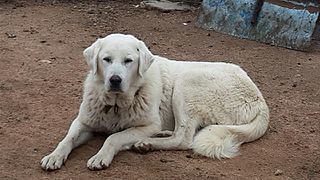
The Akbash is a traditional Turkish breed or type of flock guardian dog from western Anatolia. The word akbaş means 'white head', and thus distinguishes this dog from the Karabaş, or 'black head'. It was recognised by the Turkish Ministry of Agriculture and Rural Affairs in 2006; it is under the tutelage of the Köpek Irkları ve Kinoloji Federasyonu, the Turkish dog breed society, but is not recognised by the Fédération Cynologique Internationale.

Kars Province is a province of Turkey, located in the northeastern part of the country. It shares part of its closed border with Armenia. Its area is 10,193 km2, and its population is 274,829 (2022). The provincial capital is the city of Kars. The provinces of Ardahan and Iğdır were part of Kars Province until 1992.
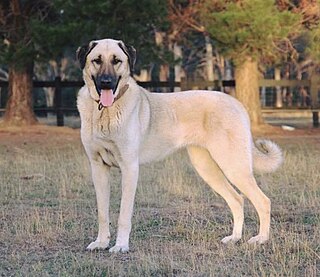
The Kangal Shepherd Dog is a traditional Turkish breed of large livestock guardian dog. The breed name derives from that of the town and district of Kangal in Sivas Province, the easternmost province of the Central Anatolia Region in central Turkey. The coat colour varies from pale fawn to wolf grey, always with a black mask.

The Caucasian Shepherd Dog or Caucasian Ovcharka is a large livestock guardian dog native to the Caucasus region, notably Georgia, Armenia, Azerbaijan, and Dagestan. It was bred in the Soviet Union from about 1920 from dogs of the Caucasus Mountains and the steppe regions of Southern Russia. The Caucasus Mountains in Georgia has historically been the principal region of distribution of Caucasian Shepherd dogs, both in terms of numbers and the quality of the dogs present in the area.
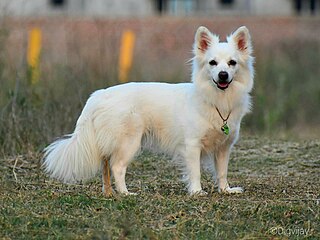
The Indian Spitz is a spitz dog breed belonging to the utility group. The Indian Spitz was one of the most popular dogs in India in the 1980s and 1990s when India's import rules made it difficult to import dogs of other breeds.
The Turkish football system is divided into the following leagues.

The Eastern Anatolia region is a geographical region of Turkey. The most populous province in the region is Van Province. Other populous provinces are Malatya, Erzurum and Elazığ.
The Anadolu Pony is a Turkish breed of horse developed over 1,000 years ago. They are known for their speed, endurance and hardiness.

The Aksaray Malaklısı or Malaklı Karabaş is a Turkish breed of large flock guardian dog from the Aksaray Province in central Anatolia. It is also known as the Turkish Mastiff or the Anatolian Lion.
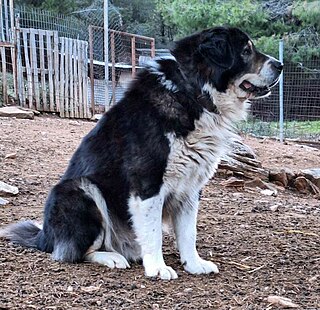
The Greek Shepherd or Greek Sheepdog is a breed of livestock guardian dog from Greece. Thought to be ancient in origin, the Greek Shepherd is very closely related to livestock guardian dog breeds from neighbouring countries; it is believed that some dogs are simultaneously claimed to be other breeds as they migrate annually across national borders with the flocks they protect in search seasonal pastures.
The Rize Koyan is a breed of livestock guardian dog from north Black Sea shore in Turkey.

The Northeast Anatolia Region (TRA) is a statistical region in Turkey.
The Kars Shepherd, Turkish: Kars Çoban Köpeği, is a Turkish breed of livestock guardian dog. It is one of three breeds of flock guardian dog in Turkey, the others being the Akbash and the Kangal.
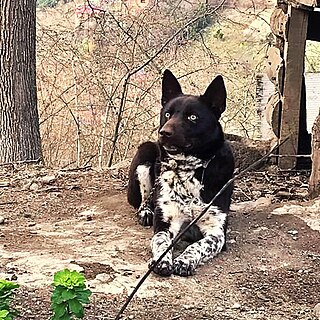
The Mekverne is an aboriginal laika dog breed native to the Black Sea region of Georgia and Turkey. Zerdava are traditionally used as guard and hunting dogs and are especially prized for boar hunting. The name “Zerdava” is Slavic for mustelid, possibly in reference to their Marten-brown color or their treeing behavior when hunting martens.
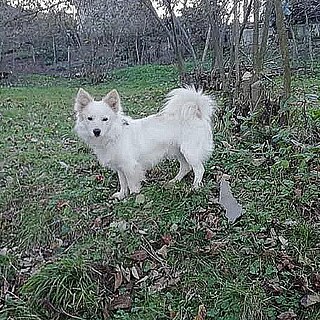
The Tonya Finosu is a white spitz dog indigenous to Trabzon, Turkey, especially the city of Tonya. Tonya Finosu are valued both for their natural suspicion of strangers as well as their playfulness and affection with their family.

The Nenets Herding Laika is an aboriginal spitz landrace of dog originating from the Yamalo-Nenets Autonomous Okrug, in Russia. Unlike other laikas, Nenets Herding Laika are less commonly used for hunting. Instead they have been selected primarily for reindeer herding ability, originally by the Nenets people, and later by reindeer herders through Russia. Nenets herding laika are thought to be the progenitor of several modern breeds, the most well-documented being the Samoyed. Despite this, the breed almost died out during the Soviet era due to lack of interest in preserving genetically purebred examples. In 1994, the Russian Kynologic Federation (RKF) approved the first official standard of the breed.
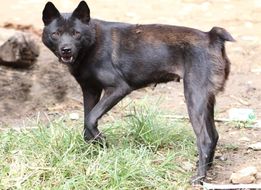
The Hmong bobtail dog is an ancient medium size spitz dog breed and one of Vietnam's Four Great National Dogs. This dog is primarily used as a hunter, herder and guard dog by the Hmong people in northern Vietnam and today they are also used as border police and military dogs. While not recognized by the Fédération Cynologique Internationale, the Hmong bobtail dog is recognized by the Vietnam Kennel Association. In 2023, the Hmong Bobtail Club of America was founded to help promote and gain recognition for the breed in the US.
The Tarsus çatalburun or Turkish Pointer is a native hound of Turkey most recognizable for its split or bifid nose. The word "çatalburuns" means forked nose. It is a very rare breed with only a few hundred specimens. The Tarsus çatalburun is not recognized by any kennel club.
References
- 1 2 Yilmaz, Orhan; Ertuğrul, Mehmet; Wilson, Richard Trevor (2019-09-22). "The domestic livestock resources of Turkey: breed descriptions and status of guard and hunting dogs". Research Gate. Retrieved 2023-07-27.
- ↑ Yilmaz, Orhan (2012). "Native Dog Breeds Of Turkey". Academia. Retrieved 2023-07-27.
- ↑ Yilmaz, Orhan; Ertuğrul, Mehmet (2012). "Türkiye Yerli Köpek Irk ve Tipleri" [Native Dogs Breeds and Types of Turkey]. Iğdır Üniversitesi Fen Bilimleri Enstitüsü Dergisi [Iğdır University Journal of the Institute of Science and Technology] (in Turkish). 2 (1): 99–106. Retrieved 2023-07-27.
- 1 2 Yilmaz, Orhan; Ertuğrul, Mehmet (2015). "Some Morphological Traits Of The Erect-Ear (Zağar) Dog in Turkey". academia. Retrieved 2023-07-27.